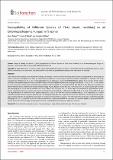| dc.description.abstract | Ticks and tick-borne disease cause severe skin damage on livestock as well as wildlife mortifying animal health and byproduct for processing and
tourism industries. Management of ticks by conventional acaricidal is environmentally and economically unaffordable in Tanzania. This study
evaluated the effectiveness of a novel entomopathogenic fungi Aspergillus oryzae (TZ/P/2018/000035) against three species of ticks (Acari:
Ioxididae); Rhipicephalus appendiculatus, Hyalomma anatolicum and Amblyomma gemma by spraying 0.2 mL/tick of 1 × 106, 1 × 107, 1 × 108 conidia/
mL of A. oryzae and control (water and 0.5% triton x-100) in 35.5°C and 85% RH repeated at 20.5°C and 70% RH in the laboratory conditions at
Nelson Mandela African Institution of Science and Technology, Arusha. Results showed that at 1 × 108 conidial/mL, A. oryzae caused high mortality
rate averaging 88.2%, 72.5% and 67.9% within 6.25 ± 0.75 days, 7.55 ± 0.59 days and 11.9 ± 0.65 days in H. anatolicum R. appendiculatus and A.
gemma respectively, whereas in control the highest mortality rate reached 12.5%, 11.0% and 6.5% after 22.50 ± 1.2, 24.6 ± 0.9 and 28 ± 2.9 days
in R. appendiculatus, H. anatolicum and A. gemma respectively at 20.5°C and 70% RH. It was also revealed that at 1 × 108 conidial/mL of A. oryzae
reduced oviposition rate in A. gemma whereby 94.8 ± 10.74 eggs/female were laid compared to control that laid 354.15 ± 42.65 egg/female. Again,
eggs averaging 166.20 ± 7.5 eggs/female were laid in H. anatolicum treated with A. oryzae at 1.0 × 108 conidia/mL compared to control that laid eggs
averaging 416.25 ± 21.71/female in cold. This study revealed that A. oryzae was effective for control of ticks could be applied in agricultural fields to
protect animal from tick’s damage consequently improving animal products in processing industry in Tanzania | en_US |

